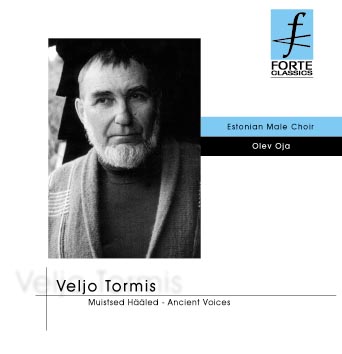Folk | Jazz | New Age | Reggae
Home | Latest News | General Tour Info

(AOR -17)
TRACK LISTING:
1. Childhood Memory
(Herding Calls) Helletused for soprano and male chorus 1982 8.01
Soloist Margarita Voites
2. Voices from Tammsaare's Herdboy's Days
Hääled Tammsaare karjapölvest
Documentary cantata for male chorus, soloists, fonogram and percussion
1977 10.10 3. Songs of the Ancient Sea Muistse mere hääled
Composition of runic songs about the sea 1979 9.074. North Russian Bylina
Pöhja-Vene böliina
for male chorus and soloists (Text arranged by V. Shtshurov) 1976 10.06
5. Conscript's Escape from Toompea Castle Home to Kuusalu Nekruti pögenemine
Tallinna Toompealt koju Kuusallu for male chorus 1969 3.25
6. Vepsian Winter Vepsa talv Vepsian chashtushkas
for male chorus 1984 4.30 7. God Protect us from War Kaitse, Jumal söja eest
for male chorus and tam-tam (Kanteletar) 1984 4.52 Recorded:1994 in Tallinn,
Estonia Total time 50.36
Veljo Tormis (b.1930), one of the most prominent Estonian composers, is a master of large-scale choral composition. Be it his monumental song cycles or extensive dramatic choral works, Tormis's colourful, nearly orchestral style of writing for voices is always remarkable. As a critic, I have often been struck by his skill of creating tensions with cumulative, seemingly monotonous repetition of an ancient folk tune, or his sound paintings disclosing unexpected resources of choral sound.
Veljo Tormis was the firstborn son of a music-loving farmer, who became the köster (i.e. organist and precentor) at the parish church of Vigala, west Estonia, when Veljo was 6 years old. His father conducted the local choir, rehearsals took place at their home, his mother singing among altos. This early experience of choral life, involvement with national ideas and feelings related to the Estonian choral movement, was certainly important for the future composer. In the age of 12 Veljo Tormis came to Tallinn to study organ at the Conservatory. That was war-time, two years before the Soviet invasion connected Estonia to the Soviet Union for the coming 50 years. The organ class, traditionally related to church service, was closed, and for a year Tormis studied choral conducting. In 1951 he continued his studies as a composer at the Moscow Conservatory with professor Vissarion Shebalin, graduating in 1956. Shebalin supported his student's interest in national style based on the use of folk music. However, the breakthrough of modern composition techniques and antiromantic attitude towards folk music took place between 1960-1965 as a result of his acquaintance with authentic sound and rhythm of peasant songs at some remote Estonian villages, impressions of the music by Carl Orff in the late 1950s, and analysis of choral music by Zoltán Kodály after a visit to Hungary in 1962. In the end of the decade Tormis finished his first great cycle "Estonian Calendar Songs" (1967) for a male and a female chorus in which the primeval enchanting power of ancient folk tunes used as the material for original choral songs was fully exposed.
In Estonian culture choral music has had outstanding role as a popular movement of amateur choruses with all-national song festivals in every five years, a movement very important for supporting Estonian identity against forceful Russification around the turn of the century and again during the Soviet years 1944-91. That has certainly contributed to the prestige of choral music in concert life and composers interest in this medium. Sophisticated choral compositions demanding a large and well-trained chorus formed a distinguished part of Estonian music already in the 1930s. Tormis continued the tradition and his music would have been impossible without a number of choruses, addressees and often commissioners of his works. Estonian National Male Chorus (formerly State Academic Male Chorus), or RAM (Riiklik Akadeemiline Meeskoor) as it is usually called, has a special position among them.
Founded in 1944 RAM soon became a symbol of Estonian music, participating at many official festivals and having some long concert tours each year. Part of its success was certainly due to the impressive new compositions of Veljo Tormis and other Estonian composers. The power and colours of a large body of trained male voices is not often used in music, probably because of the lack of appropriate performance forces. Veljo Tormis has learned much during his more than 35 years of cooperation with RAM and the result of this work amounts to about 60 cycles, compositions and shorter songs for a large male chorus, among them some of the masterpieces of choral repertory like "The Singer" (dedicated to Gustav Ernesaks, the founder of RAM, 1974)) or "The Seventeenth Rune of Kalevala" (dedicated to the 150th anniversary of the Finnish epic "Kalevala").
The present selection of compositions by Tormis performed by RAM (Olev Oja, cond.) includes works based on old folk tunes and traditional words. However, they are not folk song arrangements, rather, they have been used as a source of ideas and building material for a new concert music piece. The first composition Helletused, 1982 [Childhood Memory (Herding Calls)] is dedicated to the memory of the composer's sister. Using a selection of richly embellished vocal herding calls that were first arranged for concert use in the beginning of the century by then popular musicians Aino Tamm and Miina Härma, Tormis creates an emotional pasture scene with associations to the (past, lost) childhood through the familiar melodies. Hääled Tammsaare lapsepolvest, 1977 [Voices from Tammsaare's Herdboy Days] is written for the celebrations of the 100th anniversary of the most reckognized Estonian writer Anton Hansen Tammsaare, whose novels about peasant life in the beginning of this century form the core of Estonian education. This documentary cantata combines tape recordings and songs sung in the family of the writer into a fascinating sound picture.
For Tormis, sea is an important source of inspiration, his country home is at the coast, and he has composed a large number of songs somehow related to this theme. The composition Muistse mere laulud, 1979 [Songs of the Ancient Sea] combines excerpts from various old folk songs describing the sea, sailing or fishing together with imitations of seagulls' cries, the whistling of wind, the whisper or roaring of waves. In the early 1970s the scope of Tormis' search for archaic material widened, first including the closest Balto-Finnic people, but soon some commissions led him to different traditions -- Latvian, Bulgarian, Russian and several others. Bylina is a traditional Russian epic song and the material for Pohja-Vene boliina, 1976 [North-Russian Bylina] was arranged for Tormis by a Russian ethnomusicologist Vyacheslav Shchurov. The next two compositions Nekruti pogenemine Tallinna Toompealt koju Kuusallu, 1969 [Conscript's Escape from Toompea Castle Home to Kuusalu] and Vepsa talv, 1984 [Vepsian Winter] are the easiest in the selection, like playful scherzi. Perhaps it is interesting to know that the song about the conscript's escape describes the journey from Tallinn, Tormis' living and working place, to his country home in Kuusalu parish (also his birthplace). The Veps are a small Balto-Finnic group living on the south-western coast of the lake Onega (Äänisjärv), east to St. Petersburg. In 1983 Tormis composed a cycle Vepsian Paths belonging to his most famous series of song cycles Forgotten People, all based on ancient folk songs of Balto-Finnic peoples. Studying Vepsian materials recorded by a folklorist Marje Joalaid, Tormis has selected some jocular songs (chastushki) for Vepsian Winter and set them into a musical scene of village party with vocal imitations of concertina and other sounds. The last composition Kaitse, Jumal, soja eest, 1984 [God protect us from war] takes its text from a Finnish collection of folk poetry Kanteletar, compiled by Elias Lšnnrot in 1840-41. Although not as famous as the epic Kalevala, also compiled by Lönnrot, Kanteletar became an important source of themes and texts for later Finnish national culture. Tormis uses narrow chant-like melodic motives with traditional Kalevala-rhythm, reciting, and tam-tam to create the impression of an ancient prayer.
Urve Lippus Professor of Estonian Academy of Music

|
Latest News | General Tour Info | Top of Page
